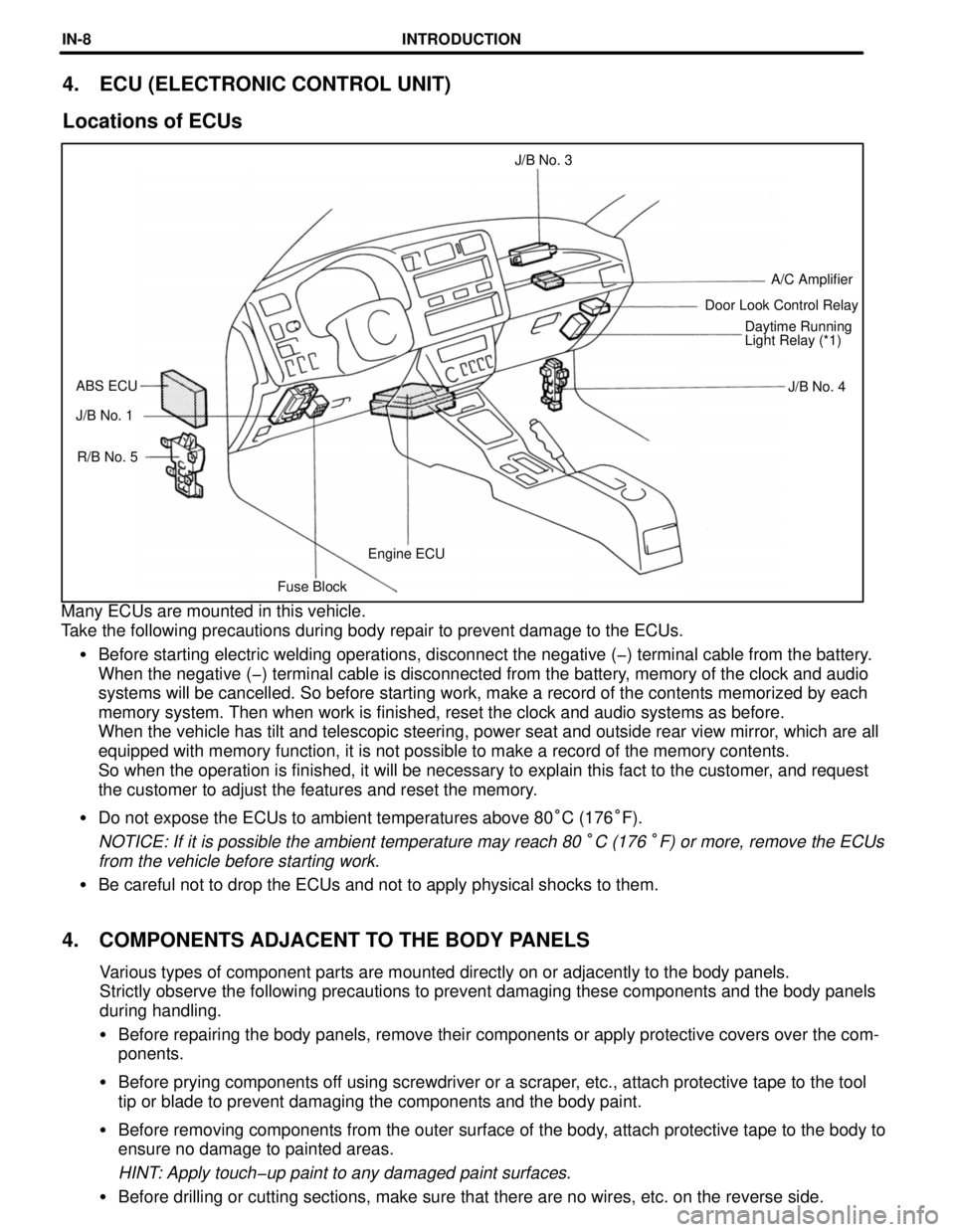Page 77 of 1354

Z15870
21
Z15871
21
Z15872
21
Z15873
21
Z15874
21 BE−56
− BODY ELECTRICALPOWER WINDOW CONTROL SYSTEM
1996 RAV4 (RM447U)
12. Passenger ’s door of 5 door models:
INSPECT POWER WINDOW MOTOR OPERATION
(a) Connect the positive (+) lead from the battery to terminal
1 and the negative (−) lead to terminal 2, check that the
motor turns clockwise.
(b) Reverse the polarity, check that the motor turns counter-
clockwise.
If operation is not as specified, replace the motor.
13. 5 Door models:
INSPECT LH REAR POWER WINDOW MOTOR OP-
ERATION
(a) Connect the positive (+) lead from the battery to terminal
1 and the negative (−) lead to terminal 2, check that the
motor turns clockwise.
(b) Reverse the polarity, check that the motor turns counter-
clockwise.
If operation is not as specified, replace the motor.
14. 5 Door models:
INSPECT RH REAR POWER WINDOW MOTOR OP-
ERATION
(a) Connect the positive (+) lead from the battery to terminal
1 and the negative (−) lead to terminal 2, check that the
motor turns clockwise.
Page 81 of 1354

BE1N1−01
Z06854
OFF
UP
OFF
DOWNRIGHT LEFT LEFT SIDE RIGHT SIDE
N11748
23
23
N11749
2 1
2 1
− BODY ELECTRICALPOWER MIRROR CONTROL SYSTEM
BE−65
1996 RAV4 (RM447U)
INSPECTION
1. INSPECT MIRROR CONTROL SWITCH CONTINUITY
Left side:
Switch PositionTester connectionSpecified condition
OFF−No continuity
UP1 − 10, 3 − 4Continuity
DOWN1 − 3, 4 − 10Continuity
LEFT1 − 9, 3 − 4Continuity
RIGHT1 − 3, 4 − 9Continuity
Right Side:
Switch PositionTester connectionSpecified condition
OFF−No continuity
UP1 − 6, 3 − 4Continuity
DOWN1 − 3, 4 − 6Continuity
LEFT1 − 2, 3 − 4Continuity
RIGHT1 − 3, 2 − 4Continuity
If continuity is not as specified, replace the switch.
2. INSPECT MIRROR MOTOR OPERATION
(a) Connect the positive (+) lead from the battery to terminal
3 and the negative (−) lead to terminal 2, and check that
the mirror turns upward.
(b) Reverse the polarity, and check that the mirror turns
downward.
(c) Connect the positive (+) lead from the battery to terminal
1 and the negative (−) lead to terminal 2, and check that
the mirror turns left side
(d) Reverse the polarity, and check that the mirror turns right
side.
If operation is not as specified, replace the mirror assembly.
Page 97 of 1354
BE278−01
BE4671
Antenna Nut
BE5781
− BODY ELECTRICALAUDIO SYSTEM
BE−81
1996 RAV4 (RM447U)
REMOVAL
REMOVE ANTENNA ROD
HINT:
Perform this operation with the negative (−) terminal cable con-
nected to the battery.
(a) Turn the ignition switch to the ”LOCK” position.
(b) Remove the antenna nut.
(c) Press the ”AM” buttons on the radio receiver, and simulta-
neously turn the ignition switch to the ”ACC” position.
HINT:
�The rod will extend fully and be released from the motor
antenna.
�After removing the antenna rod, leave the ignition switch
at ”ACC”.
NOTICE:
TO prevent body damage when the antenna rod is released,
hold the rod while it comes out.
Page 194 of 1354
BR03N−04
R04103
Sub−Wire Harness C (SST)
Sub−Wire Harness I (SST) ABS
Actuator(SST)
To Body
To Body Control Relay
− BRAKEABS ACTUATOR
BR−35
1996 RAV4 (RM447U)
ABS ACTUATOR
ON−VEHICLE INSPECTION
1. INSPECT BATTERY POSITIVE VOLTAGE
Battery positive voltage: 10 −14 V
2. DISCONNECT CONNECTORS
(a) Disconnect the 2 connectors from the control relay.
(b) Disconnect the connector from, the actuator.
3. CONNECT ACTUATOR CHECKER (SST) TO ACTUA-
TOR
(a) Connect the actuator checker (SST) to the actuator, con-
trol relay and body side wire harness through the sub−
wire harness C and I (SST) as shown.
SST 09990−00150, 09990−00200, 09990−00300
(b) Connect the red cable of the checker to the battery posi-
tive (+) terminal and black cable to the negative (−) termi-
nal. Connect the black cable of the sub−wire harness to
the battery negative (−) terminal or body ground.
Page 214 of 1354

Fuse BlockEngine ECU R/B No. 5 J/B No. 1J/B No. 4 ABS ECUDaytime Running
Light Relay (*1) Door Look Control RelayA/C Amplifier J/B No. 3
4. ECU (ELECTRONIC CONTROL UNIT)
Locations of ECUs
Many ECUs are mounted in this vehicle.
Take the following precautions during body repair to prevent damage to the ECUs.
�Before starting electric welding operations, disconnect the negative (-) terminal cable from the battery.
When the negative (-) terminal cable is disconnected from the battery, memory of the clock and audio
systems will be cancelled. So before starting work, make a record of the contents memorized by each
memory system. Then when work is finished, reset the clock and audio systems as before.
When the vehicle has tilt and telescopic steering, power seat and outside rear view mirror, which are all
equipped with memory function, it is not possible to make a record of the memory contents.
So when the operation is finished, it will be necessary to explain this fact to the customer, and request
the customer to adjust the features and reset the memory.
�Do not expose the ECUs to ambient temperatures above 80°C (176°F).
NOTICE: If it is possible the ambient temperature may reach 80 °C (176 °F) or more, remove the ECUs
from the vehicle before starting work.
�Be careful not to drop the ECUs and not to apply physical shocks to them.
4. COMPONENTS ADJACENT TO THE BODY PANELS
Various types of component parts are mounted directly on or adjacently to the body panels.
Strictly observe the following precautions to prevent damaging these components and the body panels
during handling.
�Before repairing the body panels, remove their components or apply protective covers over the comœ
ponents.
�Before prying components off using screwdriver or a scraper, etc., attach protective tape to the tool
tip or blade to prevent damaging the components and the body paint.
�Before removing components from the outer surface of the body, attach protective tape to the body to
ensure no damage to painted areas.
HINT: Apply touch-up paint to any damaged paint surfaces.
�Before drilling or cutting sections, make sure that there are no wires, etc. on the reverse side.
INTRODUCTIONINœ8
Page 272 of 1354

CodeMaterial
nameHeat*
resistant
temperature
limit °C (°F)Resistance to
alcohol or gasolineNotes
AASAcrylonitrile
Acrylic Styrene80
(176)Alcohol is harmless if applied
only for short time in small
amounts (e.g., quick wiping to
remove grease.)Avoid gasoline and
organic or aromatic
solvents.
ABSAcrylonitrile
Butadiene Styrene80
(176)Alcohol is harmless if applied
only for short time in small
amounts (e.g., quick wiping to
remove grease.)Avoid gasoline and
organic or aromatic
solvents.
AESAcrylonitrile
Ethylene Styrene80
(176)Alcohol is harmless if applied
only for short time in small
amounts (e.g., quick wiping to
remove grease).Avoid gasoline and
organic or aromatic
solvents.
BMCBulk
Moulding
Compound150
(302)Alcohol and gasoline are
harmless.Most solvents are
harmless.
CABCellulose
Acetate80
(176)Alcohol is harmless if applied
only for short time in small
amounts (e.g., quick wiping to
remove grease).Avoid gasoline and
organic or aromatic
solvents.
EPDM100
(212) Ethylene
PropyleneAlcohol is harmless.
Gasoline is harmless if applied
only for short time in small
amounts.Most solvents are
harmless but avoid
dipping in gasoline,
solvents, etc.
PAPolyamide
(Nylon)80
(176)Alcohol and gasoline are
harmless.Avoid battery acid.
PBTPolybutylene
Terephthalate160
(320)Alcohol and gasoline are
harmless.Most solvents are
harmless.
PC
Polycarbonate120
(248)Alcohol is harmless.Avoid gasoline brake
fluid, wax, wax removers
and organic solvents.
Avoid alkali.
PE
Polyethylene80
(176)Alcohol and gasoline are harmless.Most solvents are
harmless.
PETPolyethylene
Terephthalate75
(167)Alcohol and gasoline are
harmless.Avoid dipping in water.
HANDLING PRECAUTIONS
1. The repair procedure for plastic body parts must conform with the type of plastic material.
2. Plastic body parts are identified by the codes in the following chart.
3. When repairing metal body parts adjoining plastic body parts (by brazing, frame cutting, welding,
painting etc.), consideration must given to the property of the plastic.
*Temperatures higher than those listed here may result in material deformation during repair.
PLASTIC BODY PARTSPPœ2
Page 281 of 1354
Q08679No continuity
32
1
Q08680Continuity
32
1
Q08681No continuity
32
1
CL−4
− CLUTCHCLUTCH PEDAL
1996 RAV4 (RM447U)
9. CHECK OPERATION OF CLUTCH START CANCEL
SWITCH
(a) Connect positive (+) lead from the battery to terminal 3
and negative (−) lead to terminal 1.
(b) Check that there is no continuity when connecting the
positive (+) lead from the ohmmeter to terminal 2 and the
negative (−) lead to terminal 1.
(c) When push the switch, check that the indicator light
comes on and there is continuity between terminal 1 and
2.
(d) Check that there is no continuity between terminals 1 and
2 when disconnect the battery lead.
If continuity is not as specified, replace the clutch start cancel
switch.
Page 313 of 1354

S01294
CO0BS−03
S01279
Disconnect
S01277
93°C
S01290
Ammeter
Battery
S01291
Ammeter
Battery CO−18
− COOLINGELECTRIC COOLING FAN
1996 RAV4 (RM447U)
ELECTRIC COOLING FAN
ON−VEHICLE INSPECTION
1. CHECK COOLING FAN OPERATION WITH LOW TEM-
PERATURE (Below 83°C (181°F))
(a) Turn the ignition switch ON.
(b) Check that the cooling fan stops.
If not, check the cooling fan relay and ECT switch, and check
for a separated connector or severed wire between the cooling
fan relay and ECT switch.
(c) Disconnect the ECT switch connector.
(d) Check that the cooling fan rotates.
If not, check the fan main relay, cooling fan relay, cooling fan,
fuses, and check for short circuit between the cooling fan relay
and ECT switch.
(e) Reconnect the ECT switch connector.
2. CHECK COOLING FAN OPERATION WITH HIGH TEM-
PERATURE (Above 93°C (199°F))
(a) Start the engine, and raise coolant temperature to above
93°C (199°F).
(b) Check that the cooling fan rotates.
If not, replace the ECT switch.
3. INSPECT NO.1 COOLING FAN
(a) Disconnect the cooling fan connector.
(b) Connect battery and ammeter to the cooling fan connec-
tor.
(c) Check that the cooling fan rotates smoothly, and check
the reading on the ammeter.
Standard amperage: 10.9 − 13.9 A
(d) Reconnect the cooling fan connector.
4. INSPECT NO.2 COOLING FAN
(a) Disconnect the cooling fan connector.
(b) Connect battery and ammeter to the cooling fan connec-
tor.
(c) Check that the cooling fan rotates smoothly, and check
the reading on the ammeter.
Standard amperage: 9.1 − 11.1 A
(d) Reconnect the cooling fan connector.